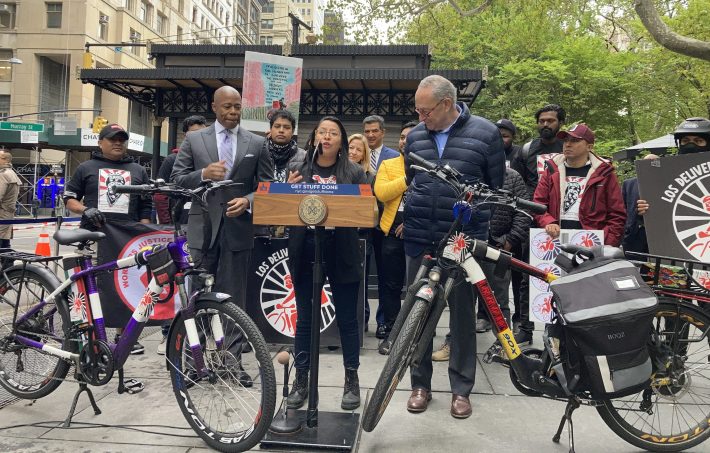Now that's rich.
Some of the city's wealthiest residents — who have turned their backs on delivery workers — are also excessively dependent on deliveristas' labor, placing tens of thousands of orders every day, according to data obtained from the Department of Consumer and Work Protection via a freedom of information request.
Across the city, New Yorkers placed 30,377,126 orders in just the last three months of 2021 — or 337,523 deliveries every single day — but in the wealthiest quarters of town, orders far outscale the citywide numbers. For example, in the Upper West Side's four ZIP codes (10023, 10024, 10025, and 10069), residents placed 1,262,805 orders between Oct. 1 and Dec. 31, 2021, or close to 14,000 orders per day in just one small neighborhood (see map below).
Yet the neighborhood's civic panel, Community Board 7, has repeatedly sought to make delivery workers' lives tougher by, for instance, opposing a resolution calling on restaurant owners to allow delivery workers to use the bathroom, rejecting a charging station and rest hub for delivery workers, and, most recently, seeking to block a plan for crosstown protected bike lanes. The board even attempted to prevent bike activists from participating in board discussions and votes, and neighborhood residents sued the city to stop a protected bike lane on Central Park West. One member of the board famously called the bathroom resolution "embarrassing," "awful" and "asinine" — positions held by many board members yet clearly hypocritical in the face of how much the neighborhood relies on workers' labor, others said.
“That’s an astonishing number of deliveries,” said Ken Coughlin, a member of Community Board 7 who supports more bike infrastructure and the rights of delivery workers. “It's an outrage that we have as little protected infrastructure as we have. It should be ubiquitous.”
But the Upper West Side is also no outlier when it comes to the number of orders fulfilled by the city’s more than 65,000 deliveristas — the majority of whom are low-income immigrant men, who take home just $7.09 per hour on average, excluding tips:
- On the east side of Manhattan, within the ZIP codes that encompass Community Board 8 — including 10021, 10028, 10044, 10065, 10075, and 10128 — residents ordered 1,361,489 food deliveries during the same time period. The Upper East Side civic panel voted last year in favor of protected crosstown bike lanes, but it's also been hesitant in the past to eagerly support new bike infrastructure.
- And in the ZIP codes that make up the bulk of Community Board 6 in Midtown East (including 10003, 10009, 10010, 10016, 10017, and 10022), residents there ordered a staggering 2,775,192 deliveries or roughly 30,000 a day.
- The ZIP code with the highest number across all five boroughs was 10016 — whose Murray Hill residents ordered 671,513 deliveries in the last three months of 2021, according to the city data.
- And in Lower Manhattan, one of the wealthiest sections of the city, residents placed 1,132,974 orders in the last quarter of 2021 — yet some residents are pushing back against a plan to widen the sidewalks and enhance pedestrian space because they say they don’t want to pay for it and don’t want to lose their ability to double park.

The Department of Consumer and Worker Protection obtained the data for the city's 192 ZIP codes from Uber Eats, Grubhub, DoorDash, and Relay, which are responsible for 99 percent of the city's food deliveries, then provided it to Streetsblog after a Freedom of Information Law request. The agency could not provide the same data for any portion of 2022.
In the city's top 20 ZIP codes with the highest income, residents splurged on $36.64 worth of delivery per person per month in the last quarter of 2021 — 73 percent more than the $21.15 spent by residents in the 20 ZIP codes with the lowest income across the city, according to the agency's report last year.

“These numbers confirm what we already know — delivery workers brave rain, snow and sleet to fulfill millions of deliveries and keep New Yorkers fed,” said Ligia Guallpa, executive director of Worker's Justice Project, which organizes Los Deliveristas Unidos, a group of delivery workers fighting for better working conditions.
Guallpa added that the data not only prove that the city needs more protected biking infrastructure and that delivery workers need safe spaces to rest and recharge, but also fair pay. In March, city leaders reportedly capitulated to lobbying efforts by the delivery apps and withdrew plans for a $23.82 minimum wage — proposing just $17.96 per hour instead to start, with the rate rising to $19.96 by 2025.
“Now more than ever, they deserve a minimum wage so they can keep their own families fed and public spaces like e-bike charging hubs that allow them to safely do their job, which millions of New Yorkers rely on,” said Guallpa.
One activist, when shown the data, said that the delivery discrepancy shows that city leaders should not listen to the residents who simultaneously vote against life-saving street safety measures while relying so often on the labor of delivery workers.
“The DCWP data on the astounding number of deliveries being made across the city underscores just how much New Yorkers rely on the city’s Deliveristas, and how critical delivery workers are to the city’s economy,” said Eric McClure, the executive director of StreetsPAC, the city's only political action committee entirely devoted to livable streets politics. “The Adams administration needs to roll out these hubs ASAP, and their siting should absolutely not be subject to NIMBY whims.”
Methodology: Streetsblog omitted several ZIP codes that were either entirely inside other ZIP codes or were too small to be statistically significant.






